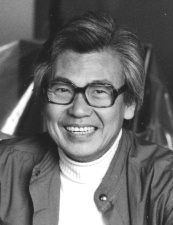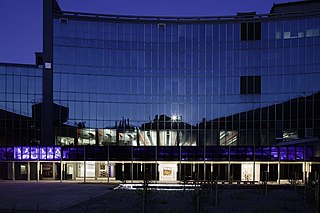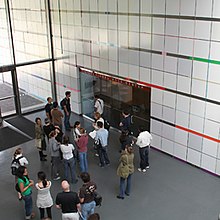Massachusetts College of Art and Design, branded as MassArt, is a public college of visual and applied art in Boston, Massachusetts. Founded in 1873, it is one of the nation's oldest art schools, the only publicly funded independent art school in the United States, and was the first art college in the United States to grant an artistic degree. It is a member of the Colleges of the Fenway, and the ProArts Consortium.
The MIT Program in Art, Culture and Technology (ACT) has its origins in the Center for Advanced Visual Studies (CAVS) at the Massachusetts Institute of Technology (MIT), an arts and research center founded in 1967 by artist and teacher György Kepes. In 2009, CAVS merged with the MIT Visual Arts Program, to become the MIT Program in Art, Culture and Technology (ACT). The Program is part of the MIT School of Architecture and Planning.
The MIT Museum, founded in 1971, is located at the Massachusetts Institute of Technology in Cambridge, Massachusetts. It hosts collections of holography, technology-related artworks, artificial intelligence, architecture, robotics, maritime history, and the history of MIT. Its holography collection of 1800 pieces is the largest in the world, though only a few selections from it are usually exhibited. As of 2023, works by the kinetic artist Arthur Ganson are the largest long-running displays. There is a regular program of temporary special exhibitions, often on the intersections of art and technology.

Otto Piene was a German-American artist specializing in kinetic and technology-based art, often working collaboratively. He lived and worked in Düsseldorf, Germany; Cambridge, Massachusetts; and Groton, Massachusetts.


The MIT School of Architecture and Planning is one of the five schools of the Massachusetts Institute of Technology, located in Cambridge, Massachusetts. Founded in 1865 by William Robert Ware, the school offered the first formal architectural curriculum in the United States, and the first architecture program in the world operating within the establishment of a university. MIT SAP is considered a global academic leader in the design field and one of the most accomplished schools in the world. MIT's department of architecture has consistently ranked among the top architecture/built environment schools in the world, and from 2015 to 2018 was ranked highest in the world in QS World University Rankings. In 2019, it was ranked second to The Bartlett but regained the number one position later on in the 2020 rankings.
Bryan Hunt is an American sculptor who was born in Terre Haute, Indiana on June 7, 1947. His family moved to Tampa, Florida in 1955. He worked at the Kennedy Space Center as an engineer's aide and draftsman, 1967–1968, during the NASA Apollo Program. In 1968, he moved to Los Angeles to enroll in the Otis Art Institute, where he received a BFA in 1971.
Agnes Denes is a Hungarian-born American conceptual artist based in New York. She is known for works in a wide range of media—from poetry and philosophical writings to extremely detailed drawings, sculptures, and iconic land art works, such as Wheatfield — A Confrontation (1982), a two-acre field of wheat in downtown Manhattan, commissioned by the Public Art Fund, and Tree Mountain—A Living Time Capsule (1992–96) in Ylojärvi, Finland. Her work Rice/Tree/Burial with Time Capsule (1968–79) is recognized as one of the earliest examples of ecological art. She lives and works in New York City.
Taylor Davis born in the United States of America, rose to recognition as an artist and a teacher. She was best known for her innovative wood sculptures.

Wen-Ying Tsai was a Chinese-American pioneer cybernetic sculptor and kinetic artist best known for creating sculptures using electric motors, stainless steel rods, stroboscopic light, and audio feedback control. As one of the first Chinese-born artists to achieve international recognition in the 1960s, Tsai was an inspiration to generations of Chinese artists around the world.

The Monash University Museum of Art (MUMA), formerly the Monash University Gallery, is a contemporary art museum on Monash University's Caulfield campus on Dandenong Road, Melbourne, Australia.

Eve Andree Laramee is an installation artist whose works explores four primary themes: legacy of the atomic age, history of science, environment and ecology, social conditions. Her interdisciplinary artworks operate at the confluence of art and science. She is currently full professor and chair of the Department of Art and Art History at Pace University. Laramee currently lives in Brooklyn, New York, and Santa Fe, New Mexico. She is also the founder and director of ART/MEDIA for a Nuclear Free Future.

Jacqueline S. Casey was a graphic designer best known for the posters she created for the Massachusetts Institute of Technology (MIT). While practicing a functional Modernism, Jacqueline S. Casey was a graphic designer in the Office of Publications from 1955 to 1989 and assigned the position as director in 1972. In discussing her design, Casey stated, "My work combines two cultures: The American interest in visual metaphor on the one hand, and the Swiss fascination with planning, fastidiousness, and control over technical execution on the other."
Brooke Kamin Rapaport is Deputy Director and Martin Friedman Chief Curator at Madison Square Park Conservancy in New York City. She is responsible for the outdoor public sculpture program of commissioned work by contemporary artists. With an exhibition of Martin Puryear's work, Martin Puryear: Liberty/Libertà, Rapaport served as Commissioner and Curator of the United States Pavilion at the 2019 Venice Biennale. She frequently speaks on and moderates programs on contemporary art and issues in public art. Rapaport also writes for Sculpture magazine where she is a contributing editor. She lives in New York City.
Judith Barry is an American artist, writer, and educator best known for her installation and performance art and critical essays, but also known for her works in drawing and photography. She is a professor and the director of the MIT Program in Art, Culture and Technology at the Massachusetts Institute of Technology, Cambridge, MA. She has exhibited internationally and received a number of awards.

La Grande Voile (The Big Sail) is a 1965 painted steel sculpture by Alexander Calder, installed in McDermott Court, on the Massachusetts Institute of Technology (MIT) campus, in Cambridge, Massachusetts, United States.

Transparent Horizon is a 1975 black Cor-ten steel sculpture by Louise Nevelson, installed on the Massachusetts Institute of Technology campus, in Cambridge, Massachusetts, United States. The artwork was among the first funded by MIT's "Percent-For-Art" program, which allocates $500,000 for art commissions for new architectural renovations on campus. The sculpture is an amalgam of two of Nevelson's previous works, Tropical Tree IV and Black Flower Series IV. The sculpture has been the target of vandalism.

Night Wall I is a sculpture by Louise Nevelson, installed outside Hauser Hall at Harvard Law School, on the Harvard University campus in Cambridge, Massachusetts, United States. The 1972 painted steel sculpture was donated to Harvard University Art Museums by Mildred and Arnold Glimcher in 1985.










